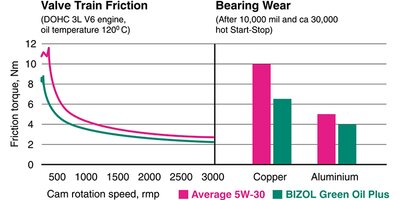Bad piston rings: symptoms, causes and solutions
Rings may be small components in an internal combustion engine, yet their significance extends to playing a pivotal role in its joint capacity and lifespan. These modest compression element bands, responsible for ensuring an airtight band within the firing chamber, play a critical role in ensuring that the engine operates efficiently and maintains optimal compression. When seals begin to fail, it can lead to a cascade of challenges that impact not only the engine's functioning but also your vehicle's fuel economy and exhaust. Discovering how to unstick bad piston rings becomes imperative in such situations.
In this comprehensive item, we will explore the signs which indicate the presence of bad piston rings, delve into the underlying grounds of their deterioration, and provide insights into the solutions available to address these issues. Whether you’re a seasoned automotive enthusiast or simply a car owner looking to appreciate more about engine health, this guide will equip you with beneficial lore to comprise your motor operating smoothly and avert expensive repairs. Let’s begin by examining the symptoms of faulty car bands.
What causes piston rings to go bad
Cylinder seals, often concealed within the heart of an inner firing propulsion system, harbor an enigmatic fragility that belies their miniature stature. Causes of piston ring failure may remain hidden, yet, as the miles accumulate and time's relentless march ensues, these guardians of compression may find themselves facing an existential crisis.
1. Lubrication's Quixotic Role
Lubrication, akin to a mystical elixir, is the engine's saving grace, quelling the fiery passions of friction. Yet, when the lubricant falters or transforms into a tainted elixir of poor quality, the cylinder bands bear the brunt. Deprived of their essential shield, they engage in a discordant struggle against friction, their wear accelerated, and their longevity imperiled.
2. Overheating
Amidst the incendiary crucible of ignition, temperatures ascend to extraordinary peaks. In this relentless inferno, compression element bands, originally engineered to endure such extremes, find themselves ensnared by the seductive allure of heat. They yield to its embrace, stretching beyond their designated confines, their struggle against the cylinder's unyielding grasp foretelling compromised compression and faltering seals.
3. Detonation Chaos
Amid the rhythmic hum of motor cycles, detonation and pre-ignition erupt as disruptive crescendos. These aberrant symphonies unleash abrupt pressure spikes within the cavity, testing the resilience of the cylinder bands. Signs of bad piston rings become evident as they battle to maintain their structural integrity.
4. Carbon's Infiltration
Carbon, an insidious infiltrator, creeps upon the seals and cylinder liners over the eons of motor operation. This clandestine buildup, an artifact of subpar fuels, neglectful maintenance, or interminable idling, tarnishes the seals’ once-gleaming surfaces. Hindered in their motion, their ability to seal with precision dwindles.
5. Foreign object ingestion
Occasionally, intruders from the outside world, like foreign entities and impurities, venture into the ignition sanctum, instigating potential harm to the piston upon their unwelcome arrival. Such incursions often find their origins in the realm of air filtration inadequacies or anomalies within the intricate web of engine intake components.
6. Maintenance: Neglecting routine attendance, such as timely oil changes and air filter replacements, can facilitate cylinder problems. Clean lubricant and proper air filtration are crucial for cylinder longevity.
In our journey through the labyrinthine causes of compression element bands degradation and the quest to understand what happens when piston rings go bad, we have unearthed a narrative that transcends the ordinary. These unassuming seals, stalwart guardians of compression, bear witness to a saga of friction, heat, and clandestine betrayals. As we proceed, we shall uncover the symptoms that betray their fall from grace and the ingenious solutions that may redeem them from the brink of oblivion.

Types and symptoms of bad piston rings
Stuck piston rings
Causes:
-
carbon deposits;
-
lack of lubrication;
-
engine overheating.
Symptoms:
-
reduced power: one of the earliest signs of stuck cylinder seals is a noticeable reduction in motor power. Your vehicle may struggle to accelerate or feel sluggish;
-
increased lubricant consumption: stuck cylinder bands can disrupt the sealing process, allowing motor lubricant to enter the combustion chamber. This often results in increased oil consumption, visible as a drop in oil levels between oil changes;
-
excessive smoke from exhaust: when lubricant enters the combustion chamber due to stuck seals, it burns along with fuel, producing blue or grayish smoke from the exhaust pipe. This is a clear indicator of an issue;
-
poor fuel economy: reduced compression caused by stuck cylinder bands can lead to decreased fuel efficiency. You might find yourself making more frequent trips to the gas station.
How to fix stuck piston rings:
-
use an engine cleaner: to address carbon deposits, you can try using an engine cleaner BIZOL GASOLINE SYSTEM CLEAN+ G80. This product is designed to break down carbon buildup and may help free stuck seals. Follow the manufacturer’s instructions for use.
-
change the oil: ensure you are using the correct oil viscosity and quality recommended by your vehicle’s manufacturer. Regular oil changes with high-quality oil are essential to prevent ring sticking. Bizol motor oil has high quality and protection for your car.
-
check the cooling system: overheating can be a root cause of stuck bands. Maintain your vehicle’s cooling system, check for leaks, and ensure the coolant levels are within the recommended range.
-
consult a mechanic: if the issue persists or worsens, it’s advisable to consult a professional mechanic. They can perform a comprehensive inspection and may recommend more advanced solutions, such as engine disassembly and band replacement if necessary.
Understanding what causes stuck piston rings is crucial in addressing this issue effectively.
cleans injectors efficiently
removes carbon deposits from intake valves and combustion chamber
increases the octane number and performance of engine
reduces fuel consumption and lowers emissions
extends the life of the fuel system
Oil guide
We will help you to find out if this product fits your vehicle in a few simple steps
Damaged piston rings
Causes:
-
wear and tear
-
lack of lubrication;
-
detonation and pre-Ignition;
-
improper break-in procedures.
Symptoms:
-
excessive oil consumption: damaged seals may allow lubricant to seep into the combustion chamber, resulting in higher oil consumption. You might notice a need for frequent oil top-ups or a drop in oil levels between changes;
-
blue or gray smoke from exhaust: oil entering the combustion chamber due to damaged seals can burn along with fuel, producing noticeable blue or grayish smoke from the tailpipe;
-
reduced compression: damaged seals compromise the engine’s ability to maintain proper compression. This can lead to decreased power, sluggish acceleration, and poor overall performance;
-
poor fuel efficiency: reduced compression and increased friction caused by damaged bands can result in decreased fuel efficiency, requiring more frequent refueling.
How to fix:
-
engine rebuild: in severe cases of cylinder seal damage, including freeing up stuck piston rings, a comprehensive motor rebuild may be necessary. This involves disassembling the motor, replacing the damaged bands, and inspecting and possibly reconditioning other internal components.;
-
regular maintenance: consistent maintenance is crucial to prevent ring damage. Use high-quality engine lubricant and adhere to recommended oil change intervals. Ensure proper engine break-in procedures are followed during initial use;
-
detonation control: address any issues related to detonation or pre-ignition promptly. This includes using the correct fuel grade and tuning the engine for optimal performance;
-
consult a professional: if you suspect damaged cylinder bands, it’s advisable to consult a qualified mechanic. They can perform a comprehensive diagnosis and recommend the most appropriate repair or replacement options based on the extent of damage.
Broken piston rings
Causes:
-
excessive heat;
-
detonation and pre-ignition;
-
manufacturing defects;
-
material fatigue.
Symptoms:
-
loss of compression: broken seals compromise the motor’s ability to maintain compression within the cylinders. This often leads to a significant reduction in motor power, resulting in poor performance and acceleration;
-
increased oil consumption: as with damaged cylinder bands, broken seals can allow oil to enter the combustion chamber. This leads to elevated oil consumption and may manifest as excessive blue or gray smoke from the exhaust;
-
knocking or pinging noises: the loss of compression can produce knocking or pinging sounds from the motor, particularly under load or during acceleration.
-
poor fuel efficiency: reduced compression and inefficient combustion due to broken cylinder bands can result in decreased fuel efficiency, requiring more frequent refueling.
How to fix:
-
motor rebuild: addressing broken cylinder seals typically necessitates an engine rebuild. This comprehensive process involves disassembling the motor, replacing the damaged bands, inspecting other internal components for wear or damage, and reassembling the motor;
-
detonation control: to prevent further damage, resolve any issues related to detonation and pre-ignition. This includes using the correct fuel grade, ensuring the motor is properly tuned, and maintaining appropriate ignition timing;
-
professional assessment: given the complexity of addressing broken cylinder bands, it is strongly recommended to consult a professional mechanic or motor specialist. They can perform a thorough diagnosis, identify the extent of damage, and recommend the most suitable repair or replacement options.
Сan you drive with bad piston rings
While driving with bad piston bands, including seized cylinder bands, is possible temporarily, it's not a recommended long-term solution. Consult a mechanic to assess the severity and determine the best course of action for your situation. In short, driving with bad cylinder bands, including seized piston rings, jeopardizes your vehicle's performance, efficiency, and long-term health.
How to prevent piston rings go bad
To prevent rings from deteriorating and to spot symptoms of piston rings failure early, adopt a regimen of proactive maintenance and responsible driving practices. Regularly change the motor oil with high-quality lubricants, adhere to recommended oil change intervals, and ensure proper cooling system maintenance. Choose the right fuel grade, follow break-in recommendations, and replace the air filter as needed. Avoid over-revving and extended idling, and be vigilant for any unusual symptoms of piston rings failure. Professional vehicle inspections and timely maintenance are also crucial to maintain the health of your cylinder seals and preserve your motor's longevity.
You might also like

Prof. Dr. Boris Zhmud, Head of R&D, BIZOL Germany

Within the realm of automotive care, few substances are as vital as motor oil, in ensuring the seamless operation of a vehicle's propelling device. It serves as the lifeblood of a motor, ensuring that the intricate machinery operates efficiently and without unnecessary friction. The functions of motor lubricant substance extend far beyond just lubrication, encompassing a range of critical tasks that contribute to the longevity and performance of a propelling mechanism. In this article, we’ll delve into the multifaceted functions of motor oil and explore how it plays a pivotal role in maintaining the health of automotive powerhouses.

The modern marvel of an internal combustion motor powers our vehicles, providing the strength and reliability we rely on for daily transportation. However, just like anything else subjected to constant use, motorized units experience wear and tear over time. Component deterioration can significantly impact performance and longevity. In this article, we will delve into the intricacies of engine wear meaning, explore the various causes behind it, provide actionable tips to reduce and prevent it. Furthermore, we will look at how specialized engine oils, such as BIZOL, play a crucial role in safeguarding your engine’s health. Let’s begin by understanding what engine wear is and the factors that contribute to it.


